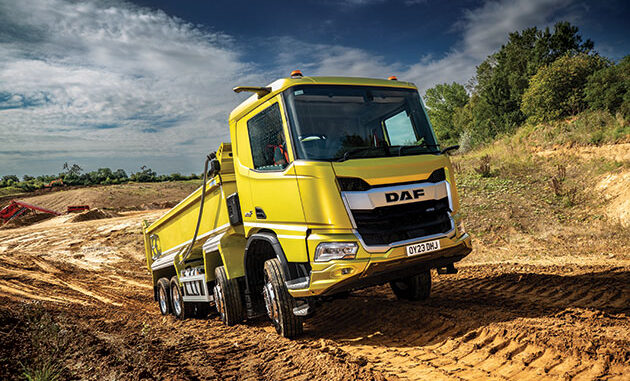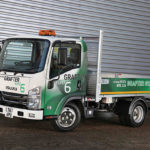
With an established tipper fleet of his own, Lochmaben Transport’s Stevie Walker spent a week in a new DAF XDC eight-wheeler.
JULY 2006 marked the end of an era for the tipper industry as Foden produced its last truck. The last 8×4 Alpha which rolled off the Leyland production line now resides in the British Commercial Vehicle Museum and is a slightly diluted version of the Foden trucks previously produced at the old Sandbach factory, as it shared the same cab and many components with its DAF counterpart.
The Alpha was a good truck, which was down to the Cummins and Caterpillar engines, Hendrickson rubber suspension, strong driveline and tough chassis, which made Foden the tipper of choice for many operators.
My opinion at the time was that when it came to tippers Paccar had backed the wrong horse. I had no intention of moving to DAF for tipper renewals instead opting for Volvo.
The Volvo brand has served us well with the robust 13 litre engine, I-shift gearbox, bomb proof driveline and chassis. It’s popular with the drivers, so much so that I have never seriously considered trying any other tipper brands, although…
…a few years back when I needed to source an 8×4 tipper quickly, I settled for a DAF CF 410; right money at the right time. That particular truck did nothing to sway me away from Volvo.
That CF had a lumpy ride, indecisive AS-Tronic gearbox, a constant array of warning lights and alarms, a turning circle on a par with an oil tanker and a chassis that creaked like a World War 2 tank.
Still, forgive and forget. When the opportunity arose to try out DAFs latest tipper offering for a week, I was more than interested to see how it compared with its predecessor, and Volvo.
The all-new DAF XDC FAD 410 8×4 chassis complete with Charlton steel body was the demo supplied, and DAF’s press and demonstration driver Mandy Wannerton did the handover at our Lockerbie premises.
She pointed out some of the truck’s features with her usual enthusiasm for the brand. I’ve noticed that Mandy refers to her trucks using the She/Her pronouns, but I thought in this case she may have got it wrong, as from certain angles the XDC in its striking Tuscan Yellow shared an uncanny resemblance to Shrek!
Joking aside though, it is a very good-looking truck, its styling does stand out in a time where many brands seem to visually morph into one another.
The chassis layout is neat and not too cluttered, making it easy to wash and allowing a bit more visibility when checking for debris or damage after any off-road excursions.
A slimline upright exhaust not only looks nice but it practically stops the truck from billowing dust onto ground workers when passing them on site. Its day cab looks compact without too many ‘sticky out bits’ to get knocked off. Front approach angle does resemble an amphibious assault vehicle and has similar levels of protection underneath to minimise any damage to the sump and radiator.
I was really impressed with the Charlton body, which went a long way to aid the stylish look of the truck. It, too, is tucked in neatly with clean lines making it easy to wash. This XDC is fitted with Kerb View door glass which doesn’t take anything away from the nearside styling but would obviously limit cab livery.
THE CAB
Access to the cab is easy with wide opening doors and the staircase effect on the steps to minimise shin bashing. This XDC is also fitted with the optional lower step designed to flex a little to stop it being snapped off.
Once parked on the seat you get a feel for the comfort levels now standard on the whole range of new DAF trucks. The seat is stylish and comfortable, with the usual full range of adjustment.
For a day cab you get a great sense of space especially with the extra six inches of room behind the seats, which allow the seats to recline much further than they would in a sleeper cab – that seat is hemmed in by the bunk – meaning you would have to set an alarm during rest breaks.
The multi-functional steering wheel looks and feels good, but the stitched leather will probably have a limited lifespan in this application unless housekeeping is especially good.
Usual steering wheel controls for dashboard display, cruise control, volume and the right-hand stalk controls the gearbox selection and engine brake, all these are positioned naturally.
The digital dashboard display can be customised to suit individual preferences, but a little time would need to be invested to get your head round all the symbols and menus.
Switchgear looks like it should stand the test of time and along with the soft touch material of the dashboard looks easy to keep clean.
There is a pull-out shelf for meals or paperwork and, best of all, a wireless phone charger is neatly positioned in the centre. The XDC was also complete with full size fridge and a parking heater, two things that will be welcomed by any tipper driver.
Top this all off with a cracking infotainment system which includes Apple CarPlay, and you have a comfortable very well-equipped day cab.
OUT AND ABOUT
Getting things on the road I soon realised how familiar I was becoming with the latest generation of DAF trucks. Designed with the driver in mind, everything essential to controlling the truck has been positioned exactly where it should be and with a couple of adjustments to the seat and steering wheel.
I was able to appreciate the levels of comfort and driveability.
When unladen, tippers tend to be noisy with a lot of banging and rattling from the body and with steel suspension you can feel every bump when on the move.
This has improved over the years as designers have tried to iron out as much of this to make the drivers lives a bit better. The XDC is exceptionally smooth and noise free which I noticed immediately as I left our premises.
Much of this is down to the fact that everything is new and tight, three years down the line with wear on the spring-eye bushes, tipper hinges and tailgate I’m sure it will fit in with the rest.
No need to run empty for long as I grabbed a load of stone for delivery to Castle Douglas, the XDCs tareweight is around 12,500kg giving a respectable 19,500kg payload.
The ride is better still with a load on its back, the suspension feels firm and planted with very little body or cab roll on corners. To make sure the brakes were working properly I decided to check them by coming to a complete stop outside the bakers in Lochmaben.
Back on the move again with a slightly increased gross weight (taking into account a coffee, filled roll and a wheel chock sized wedge of Victoria Sandwich) it should be enough to challenge the truck on a couple of long climbs towards Castle Douglas.
The first climb at Hunterhouse has several turns thrown in, willing you to not take your foot off the throttle in a bid to maintain progress. The 410hp powered through nicely with added confidence in the sure footed handling.
Descending through Torthorwald towards Dumfries was made simple with the powerful MX Engine Brake requiring no input from the brake pedal.
Improvements in the new generation sees a much stronger performance at low revs with the added benefit being that the engine brake activates instantaneously when applied, no delay like previous generations. I would say that the MX engine brake is now superior to Volvo’s equivalent.
The next long climb is what we call locally ‘The Glen’, a typically 20-to-30mph climb for most loaded trucks. This XDC took the hill in its stride with the Traxon gearbox software making all the right decisions.
I’ve noticed how it utilises the engine brake to bring the engine revs down quickly allowing quicker gear changes, a technique used by some drivers with constant mesh gearboxes on steep climbs.
ZF’s Traxon gearbox has come on in leaps and bounds over the past few years and it is now very close to Volvo’s I-Shift. There is the occasional blip that lets it down, usually a slight delay at a roundabout but otherwise very little to complain about.
YOU SEE
A quick recce of the delivery point, a new self-build in Castle Douglas, proved to be a fairly simple reverse, or at least it should have been.
Instead, it required three cuts to get into position to tip the load. I put it down NOT to my reversing skills but instead the lack of clear visual information from the Digital Vision System (DVS) replacing the conventional mirrors on the XDC.
I’ve driven with DVS many times now, and always been fairly happy with it on a tractor unit but not so much on a rigid.
The pan out feature works well on a tractor unit but is totally unnecessary on a rigid and it can be turned off in the options, I discovered a bit too late.
Also, the resolution is not great on any of the manufacturer’s systems I have used; the image of the vehicle following is too grainy to the point that you wouldn’t be able to identify which type of vehicle it is.
Once I was in position to tip, another slightly annoying issue is that the PTO is knocked out when the hand brake is released. This is to stop the vehicle being driven with the PTO engaged but it makes it very awkward and slow to tip a load as you need to be able to move forward while tipping to stop the tailgate from being damaged.
Volvo allows the truck to be driven at low revs with the PTO engaged but will not change gear until switched off which is a much more usable solution.
BECOMING FAMILIAR
With a few more loads under my belt, I was getting used to the XDC, it is such an easy truck to drive. Even on the narrow twisty roads it never felt like I was having to wrestle with it.
Visibility through the enormous, curved windscreen, the passenger kerb view window and the low belt line of the dashboard not only keeps Transport for London happy with a three-star rating, it also makes it a much easier truck to drive in building sites and quarries.
Off road performance was equally impressive, never as much as spinning a wheel on the loose sand at Hoddam Contracting’s Broom Quarry near Annan, the XDC appears to have a bit more grip than the Volvos although I was never amongst any terrain that was going to really test it.
I was hoping to get it stuck so I could try the Rock-Free feature, which allows the driver to rock the vehicle back and forth using the accelerator, a neat feature which drivers will welcome and cut down on damage to the drive train when trying to free a bogged down truck.
SUM OF ITS PARTS
I was more than impressed with my week with the XDC. It has proved to be an all-round performer with only a few minor annoyances, most of which could be ironed out at the point of placing the order.
The cab offers levels of comfort beyond what is expected for the tipper industry making for a very pleasant working environment.
Although not monitoring fuel economy – no two trucks do the same work – the XDC appeared frugal with the 410 engine more than adequate for the job. It seemed to have endless power, and the gearbox is close to perfect and offers some nice off-road features.
Probably the best for me was the way the truck handled, it felt like it was on rails and was a joy to drive and had fantastic traction.
From a driver’s point of view, I’d choose the XDC over any fourth generation Volvo FMX and FM tippers within my current fleet to do a day’s work, but would relish the opportunity to try out the latest Swedish offering.
As an operator, it’s not so clear cut. Volvo has much to offer in terms of maintenance and reliability, they are not without their faults especially when it comes to wiring and the emissions system, but they are fairly easy to work on and rarely give engine or driveline issues.
I noticed that much of DAFs driveline and suspension remains unchanged from previous versions, the wire ropes still keep the rear bogie from straying too far, something I thought could maybe have had a re-think as it has always looked like a quick fix that has been forgotten about.
I do think that there is too much technology on modern trucks especially for the tipper industry where sensitive electronics and grimy water don’t make good roommates.
The problems that come with this technology is perhaps what make us look back at the likes of Foden with rose tinted glasses.
However, the reality is that the new generation trucks like XDC are brimming with technology to get the job done quicker, safer, greener, more efficiently and with degrees of comfort that hadn’t been dreamt of back in 2006 when the last Foden’s were rolled out.




